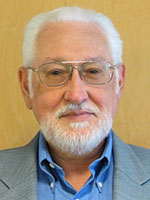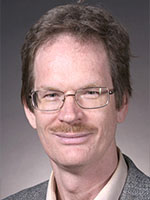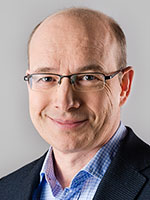Invited speakers
 |
Dr. R. Bertrum Diemer, University of Delaware, USA Title: “Simplifying Population Balances to Promote Broader Use In Industry ” The existence of similarity solutions often means that distribution shape is nearly invariant and population evolution mainly consists of the evolution of the mean size. This creates the opportunity to simplify PBMs for teaching a broader audience of everyday engineers to apply them routinely in predictive mode (forward problems), in parameter extractive mode (inverse problems), and for mechanism discrimination. In this presentation, a general framework will be developed based on power-law rate kernels for systems evolving through combinations of collisional growth, accretional growth and breakage. Characteristic times for evolution of the number mean size by these mechanisms will be identified as will cases with potential for either stationary states or similarity solutions with invariant shapes. These results will be used to argue that a monodisperse approximation offers high value for solving both forward and inverse problems. This will be illustrated in extracting model parameters from data for collision and breakage, and in simulations of carbon black-forming reactors. The discussion will conclude with an approach for mechanism discrimination illustrated in a solvent-exchange crystallization example. |
 |
Prof. Rodney O. Fox, Iowa State University, Ames, Iowa, USA Title: “Twenty years of quadrature-based moment methods: What have we learned?” Moment methods offer a computationally efficient representation of the transport of a population of particles with distributed properties (e.g., size, chemical composition, velocity). In most applications, the moments of the population balance equation (PBE) are not closed, so a realizable closure of the unknown moments in terms of known moments is required. Beginning with Robert McGraw’s 1997 paper on the quadrature method of moments (QMOM), quadrature-based moment methods (QBMM) have been developed for many different physical systems. QMOM can be applied to univariate PBEs and has a firm mathematical foundation that ensures realizability. For multi-variate PBEs or kinetic equations (or generalized PBE) where the distributed variable is the velocity, the technical challenges are different but can be divided into two general categories. For multi-variate PBEs, spatial transport involves a known velocity, so the main challenge is to construct a multi-variate quadrature to close nonlinear source terms. For the kinetic equation, spatial transport of the moments requires a hyperbolic closure, which is more restrictive than realizable. In this presentation, an overview of the status of QBMM will be provided with emphasis on issues related to population balance models. |
 |
Prof. Achim Kienle, Max Planck Institute and Otto von Guericke, University of Magdeburg, Germany Title: “Control of particle formation in fluidized beds” Particle formation in fluidized beds is an important class of processes in the chemical, pharma-ceutical and food industries. On the large scale, these processes are operated continuously. Depending on the operating conditions two different types of particle formation processes in fluidized beds can be distinguished: (i) layering granulation, when the injected liquid is a solid solution or suspension which is deposited on the particle surface leading to a layerwise growth and (ii) agglomeration, when the injected liquid is a binder The presentation gives an overview of our research results on dynamics and control of both types of particle formation processes. Results were obtained in close cooperation with the Heinrich group from TU Hamburg, the Tsotsas group from the Otto von Guericke University Magdeburg and the Buck group from FAU Erlangen. In our research, the initial focus was on layering granulation. In a first step, stabilization of open loop unstable processes with sieve mill cycle by feedback control was considered. A quantitative model for this challenging process was developed and the potential of feedback control for this class of processes was demonstrated experimentally in cooperation with the Heinrich group in TU Hamburg at a large-scale plant [3]. It was shown that the controller dampens the oscillatory behavior of the particle size distribution represented by the Sauter diameter d32 rapidly and therefore reduces the time until the system settles down to the desired steady state significantly. Theoretical and experimental results match very well. Besides particle size, particle porosity is also an important product property in many applications. For pharmaceutical processes, particle porosity is often directly related to dissolubility and efficacy of the drug. Previously, it was shown by the Tsotsas group that particle porosity mainly depends on the thermal conditions in the granulation chamber. Hence, an extended mathematical model was developed including the influence of thermal conditions [2]. This model was successfully used to develop an extended cascade control concept to stabilize the process, automatically adjust the desired particle size and porosity and reject unforeseen disturbances [1]. More recently, the focus has shifted to agglomeration processes. It turns out that physical modeling is much more difficult for this type of process. The challenge is to capture the effect of various process parameters like binder spray rate, particle feed rate and thermal process conditions on particle morphology in a quantitative way, which is essential for process control. Therefore, we have followed a hybrid modeling approach which combines population balance modeling with data-driven kernel identification. Initially, the focus was on steady state operation [5]. Results look very promising and can be extended in the future in combination with online identification for the development of new control concepts for agglomeration processes [4]. References: [1] C. Neugebauer, A. Buck, and A. Kienle. Control of particle size and porosity in continuous fluidized bed layering granulation processes with sieve mill cycle. Chem. Eng. Technol., 43:813–818, 2020. [2] C. Neugebauer, A. Buck, S. Palis, L. Mielke, E. Tsotsas, and A. Kienle. Influence of thermal conditions on particle properties in fluidized bed layering granulation. Processes, 6(12):235, 2018. [3] C. Neugebauer, E. Diez, A. Buck, S. Palis, S. Heinrich, and A. Kienle. Dynamics and control of continuous fluidized bed layering granulation with screen-mill-cycle. Powder Technol., 354:765–778, 2019. [4] E. Otto, J. Behrens, R. Durr, S. Palis, and A. Kienle. Control of particle processes. In Proc. ADCHEM 2021 (virtual), June 13-16, 2021. IFAC-PapersOnLine, Volume 54, Issue 3, Pages 231-236. [5] E. Otto, R. Durr, G. Strenzke, S. Palis, A. B ¨ uck, E. Tsotsas, and A. Kienle. Kernel identification in continuous fluidized bed spray agglomeration from steady state data. Adv. Powder Technol., 32:2517–2529, 2021. [6] C. Rieck, T. Hoffmann, A. Buck, M. Peglow, and E. Tsotsas. Influence of drying conditions on layer porosity in fluidized bed spray granulation. Powder Technol., 272:120–131, 2015. |